Queen Mary's Army Auxiliary Corps
The history of the Women's Army Auxiliary Corps which became the QMAAC and served in frontline hospitals in France during the First World War with members war graves pictures
The Queen Mary's Army Auxiliary Corps was formed on 9 April 1918 with Her Majesty as Commander-in-Chief of the Corps. It was formerly named the Women's Army Auxiliary Corps which was formed in 1917 as a result of Lieutenant General H M Lawson's report of 16 January 1917. This recommended that the army employ women in France and at home to free up more men, doing non combative work, for frontline duties. Their Chief Controller was Mrs Chalmers Watson and recruiting began in March 1917.
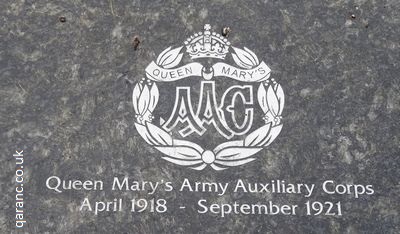
During the Great War years over 57,000 women served, including the 10,000 women employed at Royal Flying Corps air stations and transferred to the Women's Royal Air Force when they formed in April 1918. They were first sent to the front line on 31 March 1917. This was fourteen cooks and waitresses to the battlefields of France where they cooked in hospitals and camps. Their most senior officer was Helen Gwynne-Vaughan and Florence Leach was the controller of the cooks. As the First World War progressed they served in other countries like Belgium, Greece and Italy.
No rank was held, though they were known as officials (controllers and administrators) and members (workers) and divided into four sections of cookery, mechanical, clerical and miscellaneous and later included an auxiliary corps of the Royal Army Medical Corps to administer to their own personnel. Roles of the WAAC and QMAAC included telephonists, mechanics.
Their uniform was the khaki coloured uniforms of male soldiers. They wore a small cap, jacket and skirt, which was no more than twelve inches from the ground.
Five members of the Queen Mary's Army Auxiliary Corps were awarded the Military Medal during the Great War. Honours and Awards to Women: The Military Medal
Demobilisation began upon Armistice in November 1918 and the QMAAC was no longer formally in existence on the 1 May 1920 although a small unit was attached to the Graves Registrations Commission at St Pol and was disbanded on 27 September 1921.
A German air raid during World War Two saw much of their records lost, though the National Archives have now added those that did survive online. See our Service and Genealogy Records page for further details.
Ivy Lillian Campany was the last WAAC veteran. She died in 2008.
Their collection of historical photos and diaries were held in the Women's Royal Army Corps Museum in Guildford until this closed. They can now be found at the National Army Museum, Royal Hospital Road, Chelsea, London SW3 4HT.
Below are photographs and information of their war graves. We think that 8 officials and 75 members died in service during WWI.
Worker Doris Quane
Worker Quane was attached to the Reserve Battalion Cheshire Regiment. Her grave is located at St Margarets Churchyard, Bodelwyddan. The headstone reads:
10515 Worker D. Quane Q.M.Army Aux. Corps 19th April 1918.
See also Ellen Graham Thomson QMAAC.
More War Graves of Nurses.
Follow us on Facebook, Instagram and Twitter.

My PTSD assistance dog, Lynne, and I have written a book about how she helps me with my military Post Traumatic Stress Disorder, anxiety, and depression. I talk about my time in the QAs and the coping strategies I now use to be in my best health.
Along the way, I have had help from various military charities, such as Help for Heroes and The Not Forgotten Association and royalties from this book will go to them and other charities like Bravehound, who paired me with my four-legged best friend.
I talk openly about the death of my son by suicide and the help I got from psychotherapy and counselling and grief charities like The Compassionate Friends.
The author, Damien Lewis, said of Lynne:
"A powerful account of what one dog means to one man on his road to recovery. Both heart-warming and life-affirming. Bravo Chris and Lynne. Bravo Bravehound."
Download.
Buy the Paperback.

This beautiful QARANC Poppy Pin Badge is available from the Royal British Legion Poppy Shop.
For those searching military records, for information on a former nurse of the QAIMNS, QARANC, Royal Red Cross, VAD and other nursing organisations or other military Corps and Regiments, please try Genes Reunited where you can search for ancestors from military records, census, birth, marriages and death certificates as well as over 673 million family trees. At GenesReunited it is free to build your family tree online and is one of the quickest and easiest ways to discover your family history and accessing army service records.
More Information.
Another genealogy website which gives you access to military records and allows you to build a family tree is Find My Past which has a free trial.
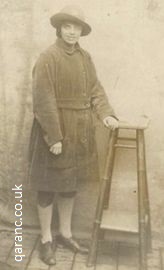
Above is Edith Lilly Taylor, known as Lily as she did not like the name Edith. She was born on the 9 March 1896 and served in France in the QMAAC as either a cook or waitress. In the group photograph below, she is in the back row, third from the right.
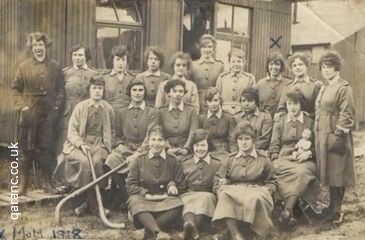
Below is her dog tag which was engraved on a French coin with her identity number 36800. It is pictured alongside her British War Medal 1914-18 and her Allied Victory Medal, both without ribbons.
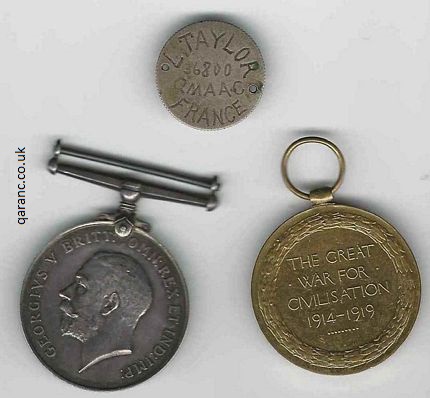
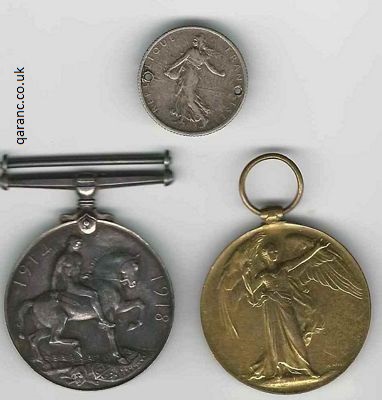
Read the World War One ID Bracelet page to discover why personnel engraved their details on metal objects.
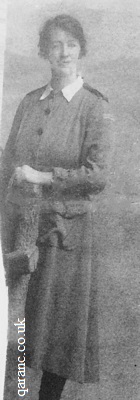
Pictured is Ann Mackay from Bettyhill, Sutherland Scotland. Mackay was her maiden name and she was born in 1897. She served in France in World War One where she met her future husband in either 1917 or 1918. He was injured and had been gassed in the trenches. He went onto serve in Archangel Russia in 1919. Sadly, his records were destroyed during the Second World War.
Her family would love to learn more about his grandmother and her photo, especially in identifying the uniform. We think she may have served in the Women's Army Auxiliary Corps (WAAC) which later became the Queen Mary's Army Auxiliary Corps (QMAAC). So, she may have been a nursing assistant or a cook. I think she may be wearing her ‘best uniform’ in the photo. Her white collar indicates a forewoman and not a worker. Or she could have been a clerk at the military base at Rouen or Wimereux.
If you can help with further information please contact me.

Former Royal Air Force Regiment Gunner Jason Harper witnesses a foreign jet fly over his Aberdeenshire home. It is spilling a strange yellow smoke. Minutes later, his wife, Pippa, telephones him, shouting that she needs him. They then get cut off. He sets straight out, unprepared for the nightmare that unfolds during his journey. Everyone seems to want to kill him.
Along the way, he pairs up with fellow survivor Imogen. But she enjoys killing the living dead far too much. Will she kill Jason in her blood thirst? Or will she hinder his journey through this zombie filled dystopian landscape to find his pregnant wife?
The Fence is the first in this series of post-apocalyptic military survival thrillers from the torturous mind of former British army nurse, now horror and science fiction novel writer, C.G. Buswell.
Download Now.
Buy the Paperback.
If you would like to contribute to this page, suggest changes or inclusions to this website or would like to send me a photograph then please e-mail me.
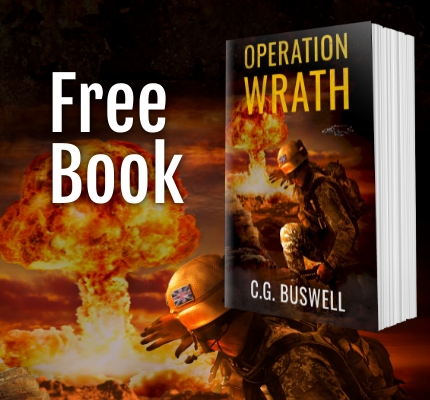
Free Book.
The death of the Brotherhood will be avenged.
RAF gunner Jason Harper and a team of Special Air Service operators are enraged after the death of their brothers by a terrorist drone strike. They fly into south-eastern Yemen on a Black-op mission to gather intelligence and avenge the death of their comrades.
Can they infiltrate the Al-Queda insurgents' camp, stay undetected, and call down their own drone missile strike and get home safely?
Will they all survive to fight another day?
Operation Wrath is a free, fast-paced adventure prequel to the non-stop action The Fence series by military veteran author C.G. Buswell.
Download for free on any device and read today.
This website is not affiliated or endorsed by The Queen Alexandra's Royal Army Nursing Corps (QARANC) or the Ministry of Defence.

